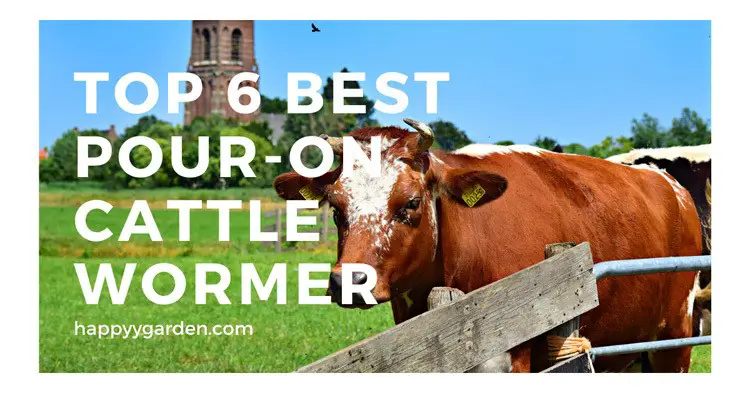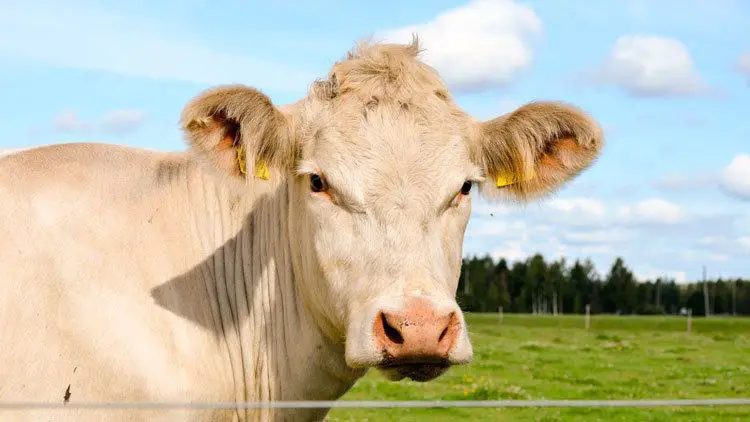Keep Your Cattle Healthy With Top 6 Best Pour On Cattle Wormer
Choosing the best pour-on cattle wormer is a big challenge for many farmers because there are many types of de-wormers in the market. Eliminating internal parasites is a big challenge for many cattle farmers. The problem is synonymous with both large-scale and small-scale farmers globally.

Top 6 best pour-on cattle wormer reviews
However, these parasites are not the same; the type of pest that will invade your cattle vary from region to region. Even though there is a variety of deworming products in the market, farmers need to choose the best pour-on cattle wormer to carb the parasite epidemic. To ensure that the cattle get the right dosage, most vets prefer injectables.
Before making the choice over which deworming product to go for, you need to have a clear understanding of how these parasites operate, active pests in your area, and the effectiveness of the de-wormer. The weight of your cattle is another critical issue to consider. Some vital factors to consider are cost, efficiency, time, and labor. The use of the right dosage is essential; otherwise, the parasites will develop resistance down the road.
Table of Contents
Best Cattle Wormer for Spring
Deworming schedules vary depending on weather conditions and geographical location. Best cattle wormer Cattle farmers are advised to collaborate with vets around them to get the most suitable deworming program. Two factors to consider when choosing the most appropriate deworming time are the type of parasite and the level of its circle.
The best cattle wormer for spring is at the beginning of the end of spring. Farmers living in humid environments should deworm their cattle three times a year. Parasites favor such a situation. For the dry regions, deworming the animals twice a year is a good plan since worms do not do well on dry matter. Springtime time is the most suitable time to deworm your cattle. Always deworm your animals at the first green-up at the beginning of spring.
Top Six De-Worming Products in The Market
Image | Product | Rating | Price |
|---|---|---|---|
The following products made to the list through evaluations by the users. Note that the mentioned products do not represent the best products in the market but rather the most preferred products in the current market. The list is aimed at helping consumers to make informed choices.
#1. Durvet Ivermectin Pour-On Dewormer 250mL
The Durvet Ivermectin Pour-On Deworme is suitable for the treated of Gastrointestinal Roundworms, Sarcoptic Mange Mites, Grub Flies, and Biting and sucking Lice. Its mode of administration is pour-on. The product is FDA approved. The high rating from consumers and effective control of broad-spectrum as well as internal and external parasites. The product comes in 250 mm. However, the farmer has a choice to buy between 2-5 bottles depending on their budget.
Features and Benefits
DavesPestDefense Cydentin Pour-On Wormer comes second in the list. This five-star product is effective in destroying both the internal and external parasites. The recommended administration is 1ml of DavesPestDefense Cydentin Pour-On Wormer for every 22 pounds. It comes with a purple dye that helps farmers differentiate the treated cattle from others. The medication is non-flammable and has no effect on milk withhold or meat withdrawal. It is most appropriate for lactating cows.
Features and Benefits
The solution can either be drenched or administered orally. The multi-purpose product is effective for eliminating nine types of major parasites. One package comes with 52 grams of medication, and you need an insignificant amount per cattle. It has a short withdrawal time and is cheap. Each packet of this product comes with the right amount of Levamisole. The product is known for reliability. Order some today and eliminate the destructive parasites from your cattle.
Dosage
Mix the content packet with fresh water. Swirl the mixture until it dissolves. Administer the content at 1/2 fl oz per 200 lbs body weight of your cattle.
Features and Benefits
The Eprinex Ivomec de-wormer comes in a sachet of 250ml. It is useful for both cows and sheep. The de-wormer is cheap can eliminate both external and internal parasites. It has zero milk and meat withdrawal. Farmers rate this product at 4.4 out of 5 because of its price and reliability.
Features and Benefits
This powerful and effective deworming product comes in 5mg Ivermectin. It eliminates Lungworms, Grubs, Lice, Horn Flies, Sarcoptic Mange Mites, and Gastrointestinal Roundworms. Despite the number of worms, it reduces, the drug is pocket-friendly. Just like any other medicine, be sure what you are treating before administering this medicine to your cattle.
Features and Benefits

Cattle Wormer Ivomec product contains 5mg of Ivermectin per ml. It eliminates both external and internal parasites. The drug enters the cattle's bloodstream through the skin. The Material's Product Satisfaction Guarantee has certified the product. The deworming medication is used to control lungworms, grubs, roundworms, biting, and sucking lice and mange mites. Not for the use of dairy breeding cattle. After administration, a 48 days withdrawal period is required.
Application
Apply through the back of the animal at 5 ml for 110 ib. Use measuring cups to make dosing easy and accurate.
Features and Benefits
Injectables Or Oral Cattle Wormer?
The primary argument for using injectables more than the pour-own is that they guarantee the right dosage. Other factors to consider are geographical location and the surrounding weather conditions. Parasites differ from region to region; therefore, treatment to combat these pests differ. Conditions favorable for one type of treatment can be unfavorable for another. Any medication does not work in isolation, and many other factors affect their effectiveness.

Injectables Or Oral Cattle Wormer?
Whether to go for injectables or Oral Cattle wormer boils down to the type of parasites affecting your cattle. Also, you need more than one type of medication. During the cattle's early stages, most vets would recommend Valbazen for injection or Dectomax for the pour. Point to note that drugs are not one-size-fits-all. The fact that it works for internal worms doesn't mean it will work for lice. For the internal parasites, injectables work better than pour-on treatment.
Understand Every Label
All medications come with stickers of instructions and dosage. For you to achieve the maximum possible results from your deworming products, it is crucial to read and understand all the names indicated on it. You must use the right product and dosage for proper treatment. If you are not careful with the instructions, you risk increasing the side effects as well as creating resistance from the parasites.
Constant under-dose deworming supply prevents your cattle from reaching their full potential. Also, you are building the worms' resistance levels. Carefully read the direction for both calves and livestock. Each label indicates the dose and the cow's weight. Right dosage, especially for calves, is essential to aid their growth. While all de-wormers are safe for cattle, some are not safe for calves, especially those under three months.
Symptoms of Worms
If regular deworming is not practiced, infected animals automatically drop in production. It is because the parasite will deny the animal the full benefits of take-in nutrients. Some of the physical appearances to look at include conspicuous ribs, rough and dough coats, and loss of weight.
Under serious worm infections, animals become anemic or may develop edema. Other conditions to look for are hair loss, restlessness, and diarrhea. Their digestive system is affected hence giving loose and smelly stool. Such animals could also experience occasional cough and may die if not treated.
Calves are more susceptible to worm infestation than older animals since older animals have developed an immunity system due to frequent attacks compared to young animals. Before six months, do not overexpose the calves into an open field pasture if you must expose them to a pasture that has not been grazed for 12 months.
How to Worm Cattle

How To Worm Cattle
Even with the best pour-on cattle wormer, deworming can fail if the right procedures are not followed. As soon as a calve hits three months, it should receive its first deworming medicine. While deworming intervals vary depending on the drugs, most de-wormers recommend a three months interval. For as long as the animals graze on the pasture, worm infestation will always be a threat to cattle.
Another factor that will largely dictate how to worm is the pasture season and management. Practices such as grazing young animals in a pasture not grazed on for 12 months will reduce the risk. Also, grazing your cattle on over-grown grass will force them to take their mouths closer to the ground hence picking up more larvae. There are several methods to use during deworming.
Oral cattle wormer
Oral cattle wormer is the use of mouth to administer the medicine to the animal. The only sure way of controlling these parasites is through regular worming measures. As mentioned earlier, you can use verbal or injections. For tablets, you require a bolus gun; liquid suspensions, on the other hand, require drenching gun or syringe. Before application, carefully read the instructions because here is where you find the best and the safest ways of use.
Both under-dozing and over-dozing pose a threat to your cattle. Under-dozing makes the parasite resistant, while over-dozing is poisonous. Deworming all your animals at a go is a good practice. Some de-wormers are not suitable for treating pregnant cows since they can lead to a miscarriage. Therefore, be careful about the type of de-warming medicine you give pregnant animals.
Before administering deworming medicine, reduce the amount of feed except water for at most 24 hours. Through this, the amount of time the anthelmintic remains and gets absorbed. For better results, keep your cattle away from food for six hours after drenching. Also, ensure that the drenching gun is calibrated well. Shake the drugs thoroughly before drawing the recommended dosage as per the animal's body weight to the gun. Hold the head of the animal straight as you drench the liquid. Finally, ensure the animal swallows the whole dose.
Handling of De-Worming Products
Chemicals are powerful poisonous products that should be kept as far as possible from children. Also, storing effects these chemicals efficiency to a great length. Most of these products have storage temperatures indicated in them. Therefore, you mustn't go with what you think, follow the manufactures instructions.
Well, this rule applies to all drugs. If you do not follow the instructions to the later, the drugs can still work for your cattle. However, their efficiency will be significantly affected. Most manufacturers recommend their products be stored in a cool and dry place. The bottom line here is to follow the manufacturer's instructions. After administering deworming or any other drug, thoroughly wash your hands.
Conclusion
Best pour-on cattle wormer practices are vital for eliminating worms in cattle. The use of de-wormers should not aim at treating the infected heard after showing signs of parasitism. Instead, it should be a treatment practice that should be performed regularly, even when the animal is healthy. The main aim of de-warming is to break the life-cycle of the parasite to reduce pasture contamination.
Both oral and injectable ways of deworming have pros and cons. The cost and workforce required to inject the entire herd can be a difficult and expensive exercise. Pour-on is pretty simple and easy to advocate and would recommend it to any farmer tone between oral and use of injection. Before ordering any deworming medicine, know the parasite you are treating. A wrong decision will be a colossal waste of money and time.






